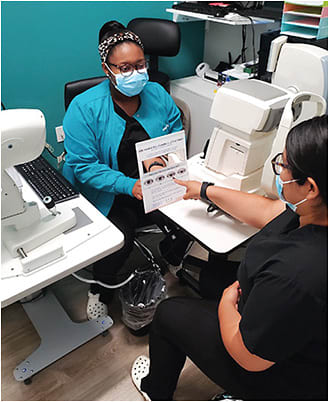
Marketing new offerings to patients who can personally benefit from them is crucial to both the sustainability and growth of the optometrist’s practice. For one, patients become loyal to doctors who stay current on the latest offerings because they know they’ll get the most advanced products and treatments to solve their vision and/or ocular health issues. For another, loyal patients breed new loyal patients by spreading the word about how their OD “always knows” about the latest innovations and, therefore, solves their vision and/or ocular health issues as a result.
Here, four optometrists who have had success with marketing new offerings provide the specific steps that have enabled them to do so.
Training/using staff
Jessilin Quint, OD, FAAO, co-owner of Smart Eye Care, in Maine, says the best place to start when introducing something new is staff training on what the offering is and how it can benefit patients before it is introduced to patients. Her reasoning:
“If you introduce something new on social media, for example, and a patient calls to inquire about it but the staff isn’t aware of it, that’s a missed opportunity to increase the patient’s interest in the product, which would lead to an appointment,” she explains.
Regarding staff training, she says the practice uses a combination of weekly staff meetings and lunch-and-learns to educate staff on new offerings and then “revisits” the education periodically, so that new innovations stay fresh in everyone’s mind.
“We recently had a lunch-and-learn to revisit an anti-presbyopia drop,” she explains. “After offering it for over a year in our offices, it was helpful to see how we could better educate ourselves and patients to best utilize it.”
Once staff are knowledgeable on the offering and they’ve determined it could meet their own vision and/or ocular health need(s), it makes sense to enable staff members to try the offering themselves. This way, if they are pleased with it, they can use their experience to market it to other patients, adds Dr. Quint.
As an example, if a staff member has severe meibomian gland dysfunction (MGD) and the practice is going to start offering intense pulsed light (IPL) to patients who share this diagnosis, this staff member can undergo the treatment and then discuss with patients who also have severe MGD, how IPL alleviated their own symptoms. In recognizing that IPL worked for someone who has their same diagnosis, patients become more likely to try it themselves, she explains.
Using chair time
Dr. Quint also suggests optometrists use chair time with the patient, as doing so helps to build the doctor/patient relationship, which creates trust and, therefore, patient buy-in to an applicable offering.
“While it’s easy to get caught up in checking off the boxes and getting through an exam, taking the time to talk to patients about what’s new that can benefit them is a valuable opportunity that should not be missed,” she stresses.
Selina McGee, OD, FAAO, CEO, and owner of BeSpoke Vision, in Edmond, Okla., says she has found success in using a separate lifestyle questionnaire that she then assesses when the patient presents to the exam room.
“My patients are always happy to provide additional information because they know it’s for the purpose of informing them about something new,” she says. “When therapeutic drops became available for ptosis and presbyopia, as examples, we added the questions, ‘would you like your eyes to be more open?’ and ‘would you like to use a drop to be less dependent on your reading glasses?’ to the questionnaire,” she explains. “Several patients answered, ‘yes’ to either or both questions, giving me an ‘in’ to introduce them to the treatment and prescribe it, if warranted.”

Employing an ‘omnichannel approach’
Dr. McGee adds that an “omnichannel approach” is important when introducing something new, as it often takes patients hearing about an offering more than once for them to take notice.
Dr. Quint agrees.
“This includes details about the new offering on the practice’s on-hold message, email blasts to those patients deemed to benefit (this entails culling through the patient record database), signage and pamphlets throughout the office, and social media posts,” she explains. “All these outlets serve to raise awareness about new offerings.”
When it comes to social media, for example, Dr. Quint says posts that contain “real people” tend to perform better than product photos.
“Whether it’s a video you’ve made or a photo that shows a patient receiving a treatment, that resonates better,” she says. “Of course, you need a patient’s permission to include them in a video or photo for HIPAA reasons.” (See bit.ly/HIPAASM2023Rules .)
Carly Rose, OD, FAAO, owner of Eyecare on the Square, in Cincinnati, Ohio, says she also uses a monthly blog, corresponding newsletter and, seeks opportunities to physically get in front of people outside the office to market new offerings.
“That has meant talking to mom groups, senior centers, and even other practitioners,” she points out. “I would also recommend connecting with local media or live news stations if you are offering something new and innovative.”
Dr. Rose divulges that her best leads on the above have come from talking with patients, neighbors, and even friends from high school about all public speaking opportunities.
“As for marketing to local doctors, I’ve always loved hosting in-house educational/value-add events, as well as doing “door-to-door” visits to introduce myself, bring baked goods, and a swag bag full of marketing assets,” Dr. Rose adds.
Janelle L. Davison, OD, owner, and CEO of Brilliant Eyes Vision Center, in Smyrna, Ga., says she often uses the Instagram “Live” feature, as well as separate videos, to make patients aware of a new offering.
“While that face-to-face chair time is the best time to connect with patients, that might only be once a year,” she points out. “The ‘Live’ feature enables me to stay in touch with patients after their yearly comprehensive eye exam, and a live broadcast creates patient excitement, as it sends the message that what’s being announced is timely and important.”
She says she also markets the services she provides to other area doctors by:
- Sending a formal letter of introduction, including new service offerings and referral instructions.
- Sending a brochure on a specific new service offered with a referral QR code and/or referral pad six weeks later.
- Sending all correspondence and progress notes to the referring doctor.
- Keeping the referral relationship going via “thank you” notes, sending treats, and hosting lunch-and-learns every six to eight weeks.

Keeping tabs
Dr. Davison asserts that it’s important to track all marketing efforts to determine which ones are working and which ones to discontinue.
“Optometrists can do this by simply asking patients how they heard about a new offering when they inquire about it,” she says. OM



